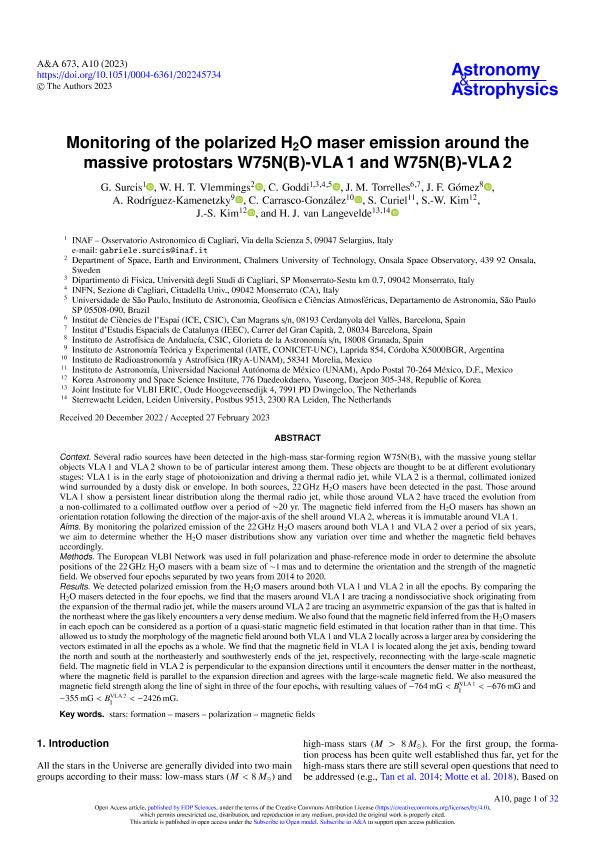Mostrar el registro sencillo del ítem
dc.contributor.author
Surcis, G.
dc.contributor.author
Vlemmings, W. H. T.
dc.contributor.author
Goddi, C.
dc.contributor.author
Torrelles, J. M.
dc.contributor.author
Gómez, J. F.
dc.contributor.author
Rodríguez Kamenetzky, Adriana Raquel

dc.contributor.author
Carrasco González, C.
dc.contributor.author
Curiel, S.
dc.contributor.author
Kim, S. W.
dc.contributor.author
Kim, J. S.
dc.contributor.author
van Langevelde, H. J.
dc.date.available
2024-02-14T14:05:48Z
dc.date.issued
2023-03
dc.identifier.citation
Surcis, G.; Vlemmings, W. H. T.; Goddi, C.; Torrelles, J. M.; Gómez, J. F.; et al.; Monitoring of the polarized H2O maser emission around the massive protostars W75N(B)-VLA 1 and W75N(B)-VLA 2; EDP Sciences; Astronomy and Astrophysics; 673; 3-2023; 1-32
dc.identifier.issn
0004-6361
dc.identifier.uri
http://hdl.handle.net/11336/226862
dc.description.abstract
Context. Several radio sources have been detected in the high-mass star-forming region W75N(B), with the massive young stellar objects VLA 1 and VLA 2 shown to be of particular interest among them. These objects are thought to be at different evolutionary stages: VLA 1 is in the early stage of photoionization and driving a thermal radio jet, while VLA 2 is a thermal, collimated ionized wind surrounded by a dusty disk or envelope. In both sources, 22 GHz H2O masers have been detected in the past. Those around VLA 1 show a persistent linear distribution along the thermal radio jet, while those around VLA 2 have traced the evolution from a non-collimated to a collimated outflow over a period of ~20 yr. The magnetic field inferred from the H2O masers has shown an orientation rotation following the direction of the major-axis of the shell around VLA 2, whereas it is immutable around VLA 1. Aims. By monitoring the polarized emission of the 22 GHz H2O masers around both VLA 1 and VLA 2 over a period of six years, we aim to determine whether the H2O maser distributions show any variation over time and whether the magnetic field behaves accordingly. Methods. The European VLBI Network was used in full polarization and phase-reference mode in order to determine the absolute positions of the 22 GHz H2O masers with a beam size of ~1 mas and to determine the orientation and the strength of the magnetic field. We observed four epochs separated by two years from 2014 to 2020. Results. We detected polarized emission from the H2O masers around both VLA 1 and VLA 2 in all the epochs. By comparing the H2O masers detected in the four epochs, we find that the masers around VLA 1 are tracing a nondissociative shock originating from the expansion of the thermal radio jet, while the masers around VLA 2 are tracing an asymmetric expansion of the gas that is halted in the northeast where the gas likely encounters a very dense medium. We also found that the magnetic field inferred from the H2O masers in each epoch can be considered as a portion of a quasi-static magnetic field estimated in that location rather than in that time. This allowed us to study the morphology of the magnetic field around both VLA 1 and VLA 2 locally across a larger area by considering the vectors estimated in all the epochs as a whole. We find that the magnetic field in VLA 1 is located along the jet axis, bending toward the north and south at the northeasterly and southwesterly ends of the jet, respectively, reconnecting with the large-scale magnetic field. The magnetic field in VLA 2 is perpendicular to the expansion directions until it encounters the denser matter in the northeast, where the magnetic field is parallel to the expansion direction and agrees with the large-scale magnetic field. We also measured the magnetic field strength along the line of sight in three of the four epochs, with resulting values of -764mG.
dc.format
application/pdf
dc.language.iso
eng
dc.publisher
EDP Sciences

dc.rights
info:eu-repo/semantics/openAccess
dc.rights.uri
https://creativecommons.org/licenses/by-nc-sa/2.5/ar/
dc.subject
MAGNETIC FIELDS
dc.subject
MASERS
dc.subject
POLARIZATION
dc.subject
STARS: FORMATION
dc.subject.classification
Astronomía

dc.subject.classification
Ciencias Físicas

dc.subject.classification
CIENCIAS NATURALES Y EXACTAS

dc.title
Monitoring of the polarized H2O maser emission around the massive protostars W75N(B)-VLA 1 and W75N(B)-VLA 2
dc.type
info:eu-repo/semantics/article
dc.type
info:ar-repo/semantics/artículo
dc.type
info:eu-repo/semantics/publishedVersion
dc.date.updated
2024-02-06T13:58:45Z
dc.journal.volume
673
dc.journal.pagination
1-32
dc.journal.pais
Francia

dc.journal.ciudad
Paris
dc.description.fil
Fil: Surcis, G.. Università degli Studi di Cagliari; Italia
dc.description.fil
Fil: Vlemmings, W. H. T.. Chalmers University of Technology; Suecia
dc.description.fil
Fil: Goddi, C.. Università degli Studi di Cagliari; Italia
dc.description.fil
Fil: Torrelles, J. M.. Università degli Studi di Cagliari; Italia
dc.description.fil
Fil: Gómez, J. F.. Consejo Superior de Investigaciones Científicas; España
dc.description.fil
Fil: Rodríguez Kamenetzky, Adriana Raquel. Consejo Nacional de Investigaciones Científicas y Técnicas. Centro Científico Tecnológico Conicet - Córdoba. Instituto de Astronomía Teórica y Experimental. Universidad Nacional de Córdoba. Observatorio Astronómico de Córdoba. Instituto de Astronomía Teórica y Experimental; Argentina
dc.description.fil
Fil: Carrasco González, C.. Universidad Nacional Autónoma de México; México
dc.description.fil
Fil: Curiel, S.. Universidad Nacional Autónoma de México; México
dc.description.fil
Fil: Kim, S. W.. Korea Astronomy and Space Science Institute; Corea del Sur
dc.description.fil
Fil: Kim, J. S.. Korea Astronomy and Space Science Institute; Corea del Sur
dc.description.fil
Fil: van Langevelde, H. J.. Leiden University; Países Bajos
dc.journal.title
Astronomy and Astrophysics

dc.relation.alternativeid
info:eu-repo/semantics/altIdentifier/url/https://www.aanda.org/10.1051/0004-6361/202245734
dc.relation.alternativeid
info:eu-repo/semantics/altIdentifier/doi/http://dx.doi.org/10.1051/0004-6361/202245734
Archivos asociados
